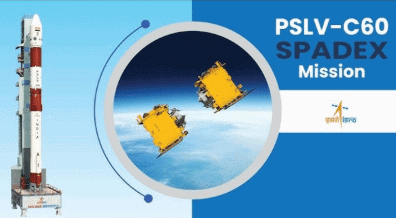PIB Summary- 17th January, 2025 | PIB (Press Information Bureau) Summary - UPSC PDF Download
SpaDeX Mission: Revolutionising Space Exploration

Context
India’s Fourth Nation Status: With the successful execution of the SpaDeX mission, India joins the elite group of countries capable of space docking operations.
Launch Details:
Mission initiated on 30th December 2024.
Spacecraft launched via PSLV-C60 from the Satish Dhawan Space Centre, Sriharikota.
Docking Success: Completed on 16th January 2025.
Technological Significance
SpaDeX demonstrates rendezvous, docking, and undocking capabilities essential for:- Satellite Servicing.
- Space Station Operations.
- Interplanetary Exploration.
Mission Objectives:
Develop and validate docking mechanisms.
- Establish control over docked satellites as a single entity.
- Demonstrate life-extension capabilities for satellites.
- Conduct power transfer between docked spacecraft.
Mission Features:
Two satellites: SDX01 (Chaser) and SDX02 (Target), each weighing ~220 kg.
Equipped with:
- Solar panels and lithium-ion batteries.
- Advanced Attitude and Orbit Control System (AOCS).
Indigenous innovations include:
- Bharatiya Docking System.
- GNSS-based Relative Orbit Determination.
- Inter-Satellite Communication Link (ISL).
Applications and Future Goals:
High-resolution imaging and resourcemonitoring.
- Preparation for ambitious missions like:
- Bharatiya Antariksh Station (BAS).
- Chandrayaan-4.
- Gaganyaan.
- Collaboration with the Department of Biotechnology to explore space biology applications.
Global and Strategic Importance:
Strengthens India’s leadership in autonomous space technology.
- Supports India’s strategic goals in space exploration, enhancing global partnerships.
- Lays groundwork for lunar sample returns and manned space missions.
Analytical Perspective:
Technological Leap:
- Marks a pivotal step in India’s transition from satellite launches to advancedspaceoperations.
- Positions ISRO for competitive participation in global space programs.
Strategic Autonomy:
- Indigenous developments reduce dependence on foreign technologies, aligning with Atmanirbhar Bharat.
Broader Implications:
- Enhances India’s capacity for space diplomacy.
- Opens avenues for commercial utilization of space technologies.
Way Forward:
- Ensure successful undocking and validate power transfer mechanisms.
- Leverage SpaDeX outcomes for operationalizing the Bharatiya Antariksh Station.
- Strengthen global collaboration in space exploration and technology sharing.
SpaDeX underscores India’s emergence as a leader in space innovation, setting the stage for a new era of scientific and strategic advancements.
Cabinet approves the establishment of “Third Launch Pad”

Context
The Union Cabinet has approved the establishment of the Third Launch Pad (TLP) at the Satish Dhawan Space Centre (SDSC), Sriharikota, Andhra Pradesh.
Objective:
To accommodate Next Generation Launch Vehicles (NGLV).
Act as a standby for the Second Launch Pad (SLP).
Support Indian human spaceflight missions and enhanced space exploration capacity.
Features and Implementation:
The TLP will be designed with universal adaptability to support multiple vehicle configurations:
- NGLV.
- LVM3 vehicles with semi-cryogenic stages.
- Scaled-up configurations of NGLV.
- Realization within 48 months (4 years).
- Emphasis on industry participation and leveraging ISRO’s prior experience.
Expenditure:
- Total estimated cost: ₹3984.86 crore, covering the launch pad and associated facilities.
Impact on Space Ecosystem:
Boosts India’s space ecosystem by enabling:
- Increased launch frequency.
- Support for human spaceflight and space exploration.
- Development of heavy-lift capabilities.
Background:
Existing Launch Infrastructure:
Current reliance on:
- First Launch Pad (FLP): Operational for 30 years, primarily supports PSLV and SSLV missions.
- Second Launch Pad (SLP): Operational for 20 years, designed for GSLV and LVM3. It also supports PSLV missions and commercial launches.
Need for a Third Launch Pad:
Increasing demands of the Amrit Kaal vision:
- Bharatiya Antariksh Station (BAS) by 2035.
- Indian crewed lunar landing by 2040.
- Requirement for new-generation, heavier launch vehicles with advanced propulsion systems.
TLP Justification:
Current launch pads are insufficient to cater to:
- Upcoming heavier-class launch vehicles.
- Increased launch frequencies for national and commercial missions.
- TLP is critical to support space transportation needs for the next 25-30 years.
Analytical Perspective:
Strategic Importance:
- Enhances national space capabilities to compete globally.
- Critical for missions like Gaganyaan, Chandrayaan, and interplanetary exploration.
- Reduces dependency on aging infrastructure, ensuring redundancy.
Economic and Industrial Implications:
- Promotes private sector participation in the space sector, aligning with Atmanirbhar Bharat.
- Strengthens India’s position as a commercial space hub, boosting exports and collaborations.
Technological Advancements:
- Supports development of semi-cryogenic engines and heavier payload capabilities.
- Enables human-rated launches and next-gen propulsion systems.
Way Forward:
- Timely execution of the TLP project to meet evolving space demands.
- Integration with future projects like NGLV, Bharatiya Antariksh Station, and Indian lunar missions.
- Strengthening private-public partnerships for innovative and cost-effective solutions.
The Third Launch Pad represents a significant step toward realizing India’s ambitious space vision, reinforcing its leadership in the global space arena.
















